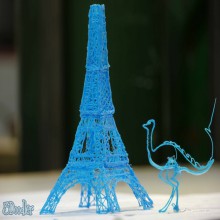From 3D Printing to 3D Pens
New technology in its earliest stages remains the domain of the scientists and inventors. Traditionally, the stumbling block has been finding a manufacturer to invest in its production, but thanks to crowd-based funding initiatives such as Kickstarter, a new model may supplement or even supplant the investor setup.
 Additive manufacturing is a prime example of a new technology that may soon make its introduction to the everyday market as a result of crowd-sourcing, thanks to the impressive funding effort behind a pen called the 3Doodler.
Additive manufacturing is a prime example of a new technology that may soon make its introduction to the everyday market as a result of crowd-sourcing, thanks to the impressive funding effort behind a pen called the 3Doodler.
When private companies and startups need money to fund research and development projects, they hold investment rounds and venture capital groups pour money into what they deem profitable.
The rest of us resort to things like Kickstarter, which is where Boston-based WobbleWorks went to fund their 3D printing pen. They needed $30,000 to start production and distribution of a $75 pen that would allow users to draw corporeal objects essentially out of thin air. Seven days after the launch of their campaign, they have already raised $1,886,027.
The 3Doodler essentially works as an individual 3D ink dropper. From a tip at the end, heated ABS plastic, the same material used as ink in many 3D printers today, can be dispensed onto a surface or into the air to create an object. The 3Doodler resembles the hot glue gun used in many an art project, connecting to an energy source that would heat the plastic into a semi-liquefied state such that it cools solid almost instantly.
At first glance, it seems as if the 3Doodler has few practical applications other than creating neat plastic art. However, the notion of opening up even a small part of 3D printing to the consumer market is obviously enough to get people excited to the tune of $1.8 million. Beyond the printing parallels, however, surely some of that investment has to do with the group’s partnership with artists at Etsy, which has led to some templates of wiry 3D art projects that would potentially be made possible by the 3Doodler.
Beyond that, an improved, more streamlined version could hypothetically create tools or every day household objects, such as a container or cup, out of thin air (and a cartridge of ABS plastic) even if this iteration of the 3Doodler seems unlikely to accomplish such goals.
Full story at Wired










